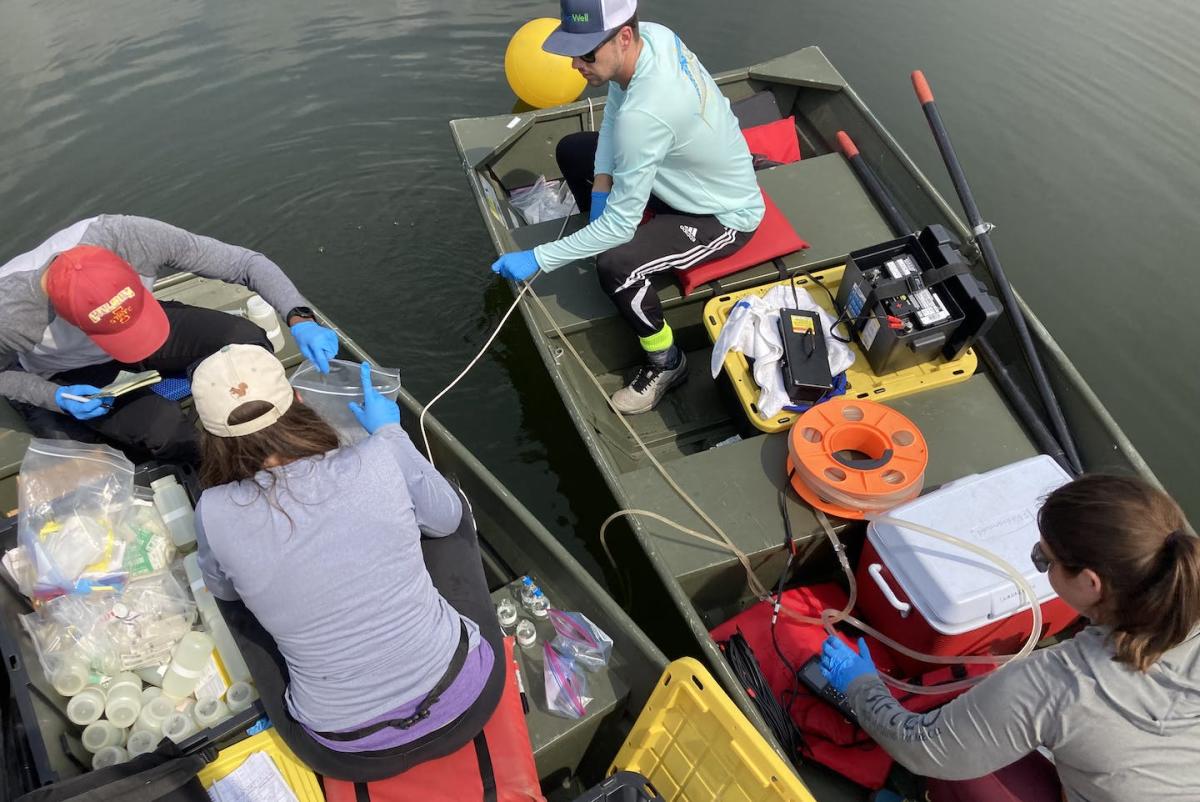Little Deming Lake may not receive much attention from tourists visiting Itasca State Park in Minnesota, since Lake Itasca, the headwaters of the Mississippi River, offers better boating opportunities. However, as a geochemist interested in the development of oxygen in the Earth’s atmosphere billions of years ago, Deming Lake holds a special allure for me. This small lake shares a unique characteristic with the early Earth’s oceans – the absence of oxygen in its deeper layers.
During our expeditions to Deming Lake, my colleagues and I navigate through a narrow path obscured by late-summer poison ivy, hauling hundreds of pounds of equipment to launch our rowboats. Despite its surface area being only 13 acres, we row our boats over 60 feet (18 meters) into the deepest part of the lake. Once anchored, we connect our boats to form a flotilla, preparing ourselves for the research ahead.
Little Deming Lake is classified as meromictic, a term derived from Greek meaning partially mixed. Most lakes undergo a process known as turnover at least once a year, where the top layer of water sinks and the bottom layer rises due to wind and seasonal temperature changes. However, in Deming Lake, the deepest waters never reach the surface, preventing oxygen from the top layer from mixing into the deep layer. Less than 1% of lakes exhibit meromictic characteristics, and those that do usually have dense, salty bottom waters. Deming Lake, on the other hand, is not highly saline, but it does contain an abundance of iron in its deep waters, making it one of the rarest types of meromictic lakes.
On a tranquil August morning, we lower a water pump attached to sensors into Deming Lake. These sensors measure various parameters such as temperature, oxygen levels, pH, and chlorophyll content at different depths. We collect water samples from intriguing layers to conduct chemical and biological analyses. Our focus at Deming Lake is to study how microbial life adapted to and influenced the environmental conditions on early Earth. For most of Earth’s history, microorganisms were the sole inhabitants, and the atmosphere and oceans had minimal oxygen but ample iron, much like Deming Lake. By studying the microbes in Deming Lake, we hope to gain insights into how they shaped the Earth’s atmosphere and oceans over billions of years.
Around 2.5 billion years ago, the oceans contained sufficient iron to form the banded iron formations found worldwide today, which serve as a valuable source of iron for the modern steel industry. Present-day oceans have only trace amounts of iron but abundant oxygen. Iron and oxygen typically do not coexist harmoniously due to rapid chemical and biological reactions between them. Cyanobacteria, single-celled organisms that emerged at least 2.5 billion years ago, were responsible for the rise of oxygen in the early atmosphere and oceans through photosynthesis. However, it took approximately 2 billion years for oxygen levels to reach a point where animal life could thrive.
In Deming Lake, we pay close attention to the layer with a significant increase in chlorophyll readings. Chlorophyll, the pigment that imparts a green color to plants, enables them to convert water and carbon dioxide into oxygen and sugars using sunlight energy. At a depth of nearly 20 feet (6 meters) below the surface of Deming Lake, the chlorophyll is found in cyanobacteria and photosynthetic algae. Interestingly, despite the abundance of oxygen-producing organisms, no oxygen is detected in this layer. This is also the depth at which iron concentrations start to rise to high levels found at the bottom of the lake.
This high-chlorophyll, high-iron, and low-oxygen layer intrigues us because it offers insights into the living conditions of cyanobacteria in the ancient oceans, their growth patterns, and their oxygen production. We suspect that cyanobacteria congregate at this depth in Deming Lake due to the higher iron content compared to the surface layers. Just like humans require iron for red blood cells, cyanobacteria need ample iron to facilitate photosynthesis reactions. The lack of measurable oxygen in this layer may be attributed to the presence of other bacteria that rapidly consume any oxygen produced by the still-photosynthesizing cyanobacteria.
Apart from measuring oxygen levels, it is crucial to track the production of new sugars through photosynthesis, particularly by cyanobacteria. To achieve this, we collect water samples from Deming Lake’s chlorophyll-rich layer and seal them in glass bottles. Back in the laboratory, we introduce a carbon dioxide solution with an isotopic tracer into the bottle. If cyanobacteria are growing, their cells will incorporate this isotopic marker. This approach provides a more comprehensive understanding of photosynthesis than solely measuring oxygen levels.
While waiting for the incubation process to complete, we gather water samples from different layers of the lake and preserve them using chemicals that kill the cells while preserving their bodies. These samples will be examined under a microscope to determine the abundance of cyanobacteria and measure the iron content within their cells. The process of separating the cyanobacteria from other cell types and removing external iron is challenging but essential. At Iowa State University, we will subject individual cyanobacteria cells to a flame that incinerates them, liberating the iron content, which can then be measured.
Our research at Deming Lake is motivated by the desire to unravel the mysteries of Earth’s early environment and the role microbes played in transforming its atmosphere and oceans. By studying the unique characteristics of this meromictic lake, we hope to gain insights that help us better understand the history of our planet and its ecosystems.


